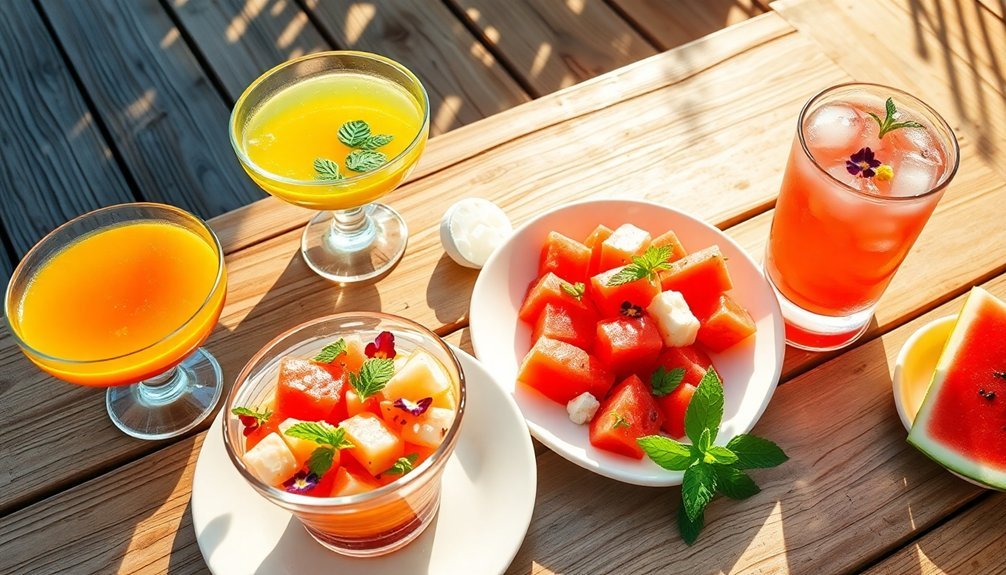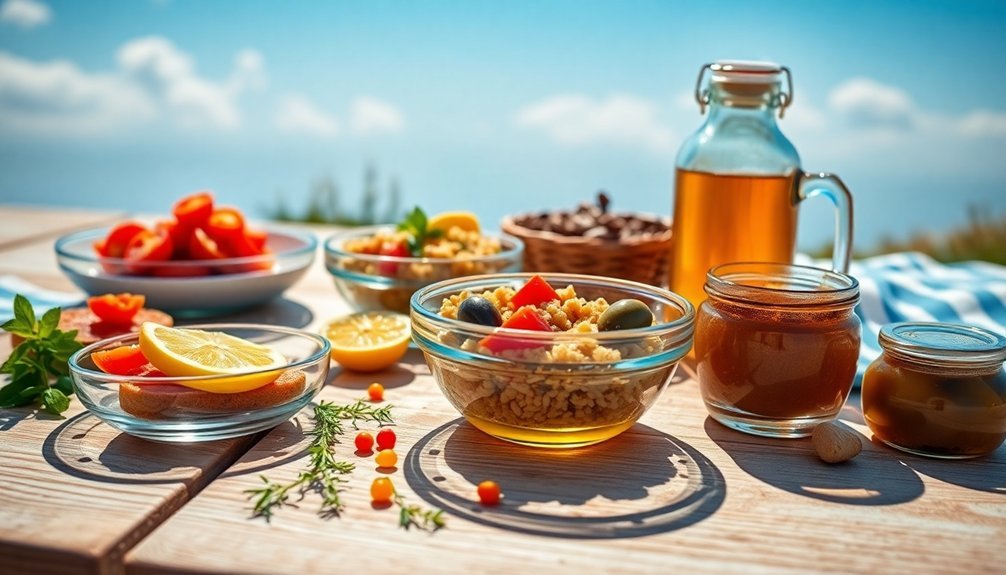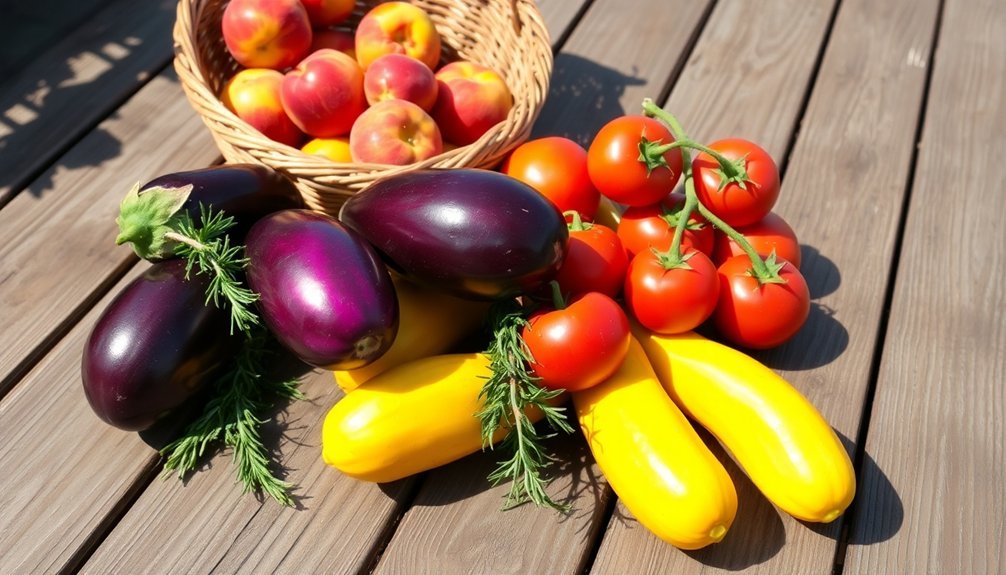For sun-powered cooking success, you'll want to focus on recipes that match the weather conditions. Start with no-cook favorites like antipasto platters and watermelon feta salads while your solar station heats up. Position your cooking setup in direct sunlight, using dark cookware to maximize heat retention, and monitor temperatures closely. Quick-cooking options like shrimp skewers and open-faced omelets work best on clear, dry days, while seasonal ingredients like bell peppers and tender broccoli guarantee top-notch results. Your journey into solar cuisine opens up a world of sustainable, energy-efficient meal possibilities.
Best Recipes For Hot Weather

When summer temperatures soar, turning on the oven or stove can feel like torture. You'll find relief with no-cook and low-cook options that keep your kitchen cool.
Try an antipasto salad loaded with cold meats and cheeses, or whip up a Mediterranean tuna salad that's both invigorating and protein-rich.
For minimal cooking, you can't go wrong with quick quesadillas. Choose from zucchini, spinach and white bean, or black bean varieties that need just minutes in a skillet. The creamy spinach quesadillas only cost about $1 per serving while delivering a satisfying crunch.
If you're craving something lighter, opt for a watermelon feta salad or cucumber sandwiches that require zero heat.
When you do need to cook, consider using a solar oven for fun treats like English muffin pizzas or s'mores, letting the sun do all the work while you stay cool.
Setting Up Your Solar Station
Before diving into solar cooking, you'll need to properly set up your solar station for ideal performance and safety. Start by connecting your battery system, confirming you match the positive and negative terminals to your charge controller using stranded copper wire. Always keep solar panels covered during installation while making connections.
Next, connect your solar panels following the adapter kit instructions. Pay close attention to polarity to prevent damage. Mount the panels securely to your rails using end and mid clamps, making all wire connections before final mounting.
Install your inverter by connecting it directly to the battery with ring cables, maintaining correct polarity throughout.
Route all wiring through a junction box and disconnect switch, terminating at your circuit breaker box. Don't forget proper grounding for both AC and DC circuits to confirm safe operation of your solar cooking station.
Quick Dishes Under Clear Skies

Since bright sunshine promises ideal cooking conditions, you'll find these quick solar recipes perfect for maximizing your outdoor culinary adventures.
Start your day with a breakfast frittata that cooks in just 35 minutes, combining eggs, vegetables, and cheese for a hearty meal. For larger gatherings, try the open-faced omelet that serves eight and uses parchment paper for easy cleanup.
If you're craving seafood, prepare shrimp and lemon skewers that cook in 10-20 minutes. Simply marinate the shrimp, thread them onto skewers, and let the sun work its magic.
For a sweet treat, bake solar scones using a mix of flours, oats, and dried fruits. While they take an hour to cook, these delicious pastries are worth the wait and yield eight servings. These nutrient-rich scones provide 476 calories per serving and make an excellent energy-boosting snack.
Solar Temperature Control Tips
While mastering solar cooking requires practice, controlling temperature is the key to achieving consistent results.
You'll need to position your solar oven in full sunlight and adjust the reflectors to concentrate maximum heat into the cooking chamber. Keep a thermometer handy to monitor internal temperatures throughout the cooking process.
For ideal heat retention, use dark-colored cookware and cooking bags to insulate your dishes.
Don't forget to reposition your oven every 30 minutes to track the sun's movement. When using a parabolic cooker, wear protective sunglasses and avoid looking directly at the reflected light.
Remember to cut ingredients into smaller pieces to guarantee even cooking, and adjust your cooking times based on the temperature readings.
You'll get the best results by choosing recipes that work well with gentle, sustained heat.
Seasonal Ingredients To Choose

Selecting the right seasonal ingredients for solar cooking guarantees ideal results and makes the most of nature's bounty.
During winter, you'll want to focus on hearty vegetables like potatoes, sweet potatoes, and winter squash that can withstand longer cooking times.
As spring arrives, switch to quick-cooking artichokes, asparagus, and tender broccoli florets.
Late spring and early summer bring colorful bell peppers and fresh berries that are perfect for light solar-cooked desserts.
When fall approaches, you can't go wrong with crisp apples, earthy beets, and Brussels sprouts.
These autumn vegetables hold up well in your solar cooker and develop rich flavors under the sun's heat.
Remember to match your cooking times with the season's sun intensity – lighter fare in spring and heartier dishes in fall and winter.
Frequently Asked Questions
Can Solar Ovens Work Effectively on Cold but Sunny Days?
Yes, you'll find solar ovens work well on cold, sunny days. They'll maintain high temperatures if they're properly insulated and sealed. Cold air's lower humidity actually helps, as there's less moisture to scatter sunlight.
How Do Different Altitudes Affect Solar Cooking Times and Temperatures?
You'll find that higher altitudes actually improve solar cooking efficiency due to less atmospheric interference. While water boils at lower temperatures up high, you'll get more direct solar radiation for faster cooking times.
What Happens if Clouds Appear Halfway Through Cooking?
If clouds appear mid-cooking, you'll notice slower cooking and lower temperatures. You should extend cooking time, use a heat-retention basket, or transfer food to a backup cooking method to guarantee it's fully cooked.
Are Solar-Cooked Foods as Nutritious as Traditionally Cooked Meals?
You'll get comparable nutrition from solar-cooked foods, and they may retain more nutrients than traditional methods. However, vitamin C levels can be lower due to longer cooking times, while proteins and minerals are well preserved.
Can Solar Ovens Be Used to Sterilize Water for Drinking?
Yes, you can sterilize drinking water using solar ovens. They'll heat water to safe temperatures (70-75°C) and use UV radiation to kill harmful microorganisms. Just make certain you're using clear containers and have sufficient sunlight.
In Summary
You'll find these sun-powered recipes transform your summer cooking while saving energy and keeping your kitchen cool. Make the most of nature's heat by timing your meals with peak sunlight and selecting seasonal ingredients that shine in solar preparation. Remember to check your local weather forecast, keep safety in mind, and you'll soon master the art of cooking with nothing but sunshine and smart planning.





Leave a Reply